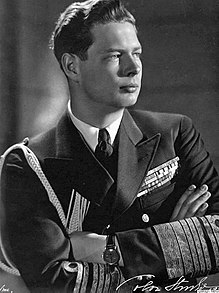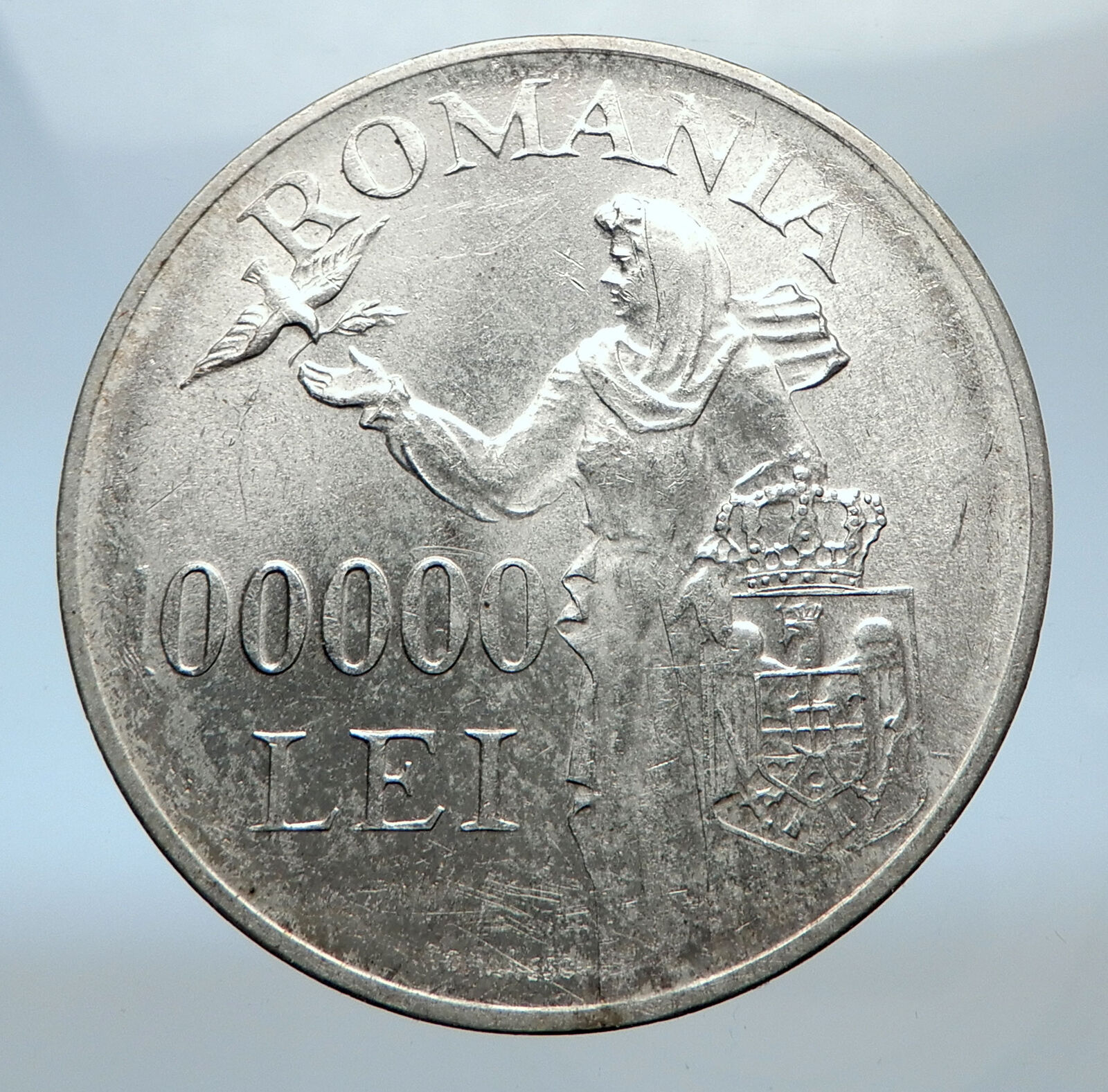|
Romania – under Michael I – (1927 to 1930, 1940 to 1947)
Bessarabia Reunion
1944 Silver 500 Lei 31mm (11.89 grams) 0.700 Silver (0.2701 oz. ASW)
Reference: KM# 65
MIHAI I REGELE ROMANILOR H. IONESCU, Michael facing left.
ROMANIA 19 44 500 LEI, Coat-of-arms.
Edge Lettering:
NIHIL SINE DEO
You are bidding on the exact item pictured, provided with a Certificate of Authenticity and Lifetime Guarantee of Authenticity.
The unification of Romania and Moldova (Romanian: Unirea Republicii Moldova cu România) is a popular concept in the two countries beginning with the late 1980s, during the collapse of communism. The Romanian Revolution in 1989 and the independence of Moldova in 1991 further contributed to the development of a movement for the unification of the two Romanian-speaking countries. The question of reunification is recurrent in the public sphere of the two countries, often as a speculation, both as a goal and a danger. The idea, while widespread in Romania, is only supported by a minority in Moldova.
Individuals who advocate the unification are usually called “unionists” (unioniști). Some support it as a peaceful process based on consent in the two countries, others in the name of a “Romanian historical right over Bessarabia”. The supporters of the union refer to the opponents as “Moldovenists” (moldoveniști) or “Statalists” (stataliști).
 Michael I (Romanian: Mihai I [miˈhaj]; 25 October 1921 – 5 December 2017) was the last King of Romania, reigning from 20 July 1927 to 8 June 1930 and again from 6 September 1940 until his abdication on 30 December 1947. Michael I (Romanian: Mihai I [miˈhaj]; 25 October 1921 – 5 December 2017) was the last King of Romania, reigning from 20 July 1927 to 8 June 1930 and again from 6 September 1940 until his abdication on 30 December 1947.
Shortly after Michael’s birth, his father Prince Carol had become involved in a controversial relationship with Magda Lupescu. In 1925, Carol was eventually pressured to renounce his rights to the throne and moved to Paris in exile with Lupescu. In 1927, Michael ascended the throne, following the death of his grandfather, Ferdinand I. As he was still a minor, a regency council was instituted which comprised his uncle, Prince Nicholas; the Patriarch Miron Cristea; and the president of the Supreme Court, Gheorghe Buzdugan. The council proved to be ineffective and in 1930, Carol returned to Romania and replaced his son as king, reigning as Carol II. As a result, Michael returned to being heir apparent to the throne and was given the additional title of Grand Voievod of Alba-Iulia.
Carol II was deposed in 1940, and Michael once again became king. Under the government led by the military dictator Ion Antonescu, Romania became aligned with Nazi Germany. In 1944, Michael participated in a coup against Antonescu, appointed Constantin Sănătescu as his replacement, and subsequently declared an alliance with the Allies. In March 1945, political pressures forced Michael to appoint a pro-Soviet government headed by Petru Groza. From August 1945 to January 1946, Michael went on a “royal strike” and unsuccessfully tried to oppose Groza’s Communist-controlled government by refusing to sign and endorse its decrees. In November, Michael attended the wedding of his cousins, the future Queen Elizabeth II of the United Kingdom and Prince Philip of Greece in London. Shortly thereafter, on the morning of 30 December 1947, Groza requested a meeting with Michael where he was forced to abdicate. Michael was forced into exile, his properties confiscated, and his citizenship stripped. He married Princess Anne of Bourbon-Parma in 1948, with whom he had five daughters, and eventually settled in Switzerland.
Nicolae Ceaușescu’s communist dictatorship was overthrown in 1989 and the following year Michael attempted to return to Romania, only to be arrested and forced to leave upon arrival. In 1992, Michael was allowed to visit Romania for Easter where he was greeted by huge crowds; a speech he gave from his hotel window drew an estimated one million people to Bucharest. Alarmed by Michael’s popularity, the post-communist government of Ion Iliescu refused to allow him any further visits. In 1997, after Iliescu’s defeat by Emil Constantinescu in the presidential elections of the previous year, Michael’s citizenship was restored and he was allowed to visit Romania again. Several confiscated properties, such as Peleş Castle and Săvârşin Castle, were eventually returned to his family.
 Romania is a country located at the crossroads of Central, Eastern, and Southeastern Europe. It borders the Black Sea to the southeast, Bulgaria to the south, Ukraine to the north, Hungary to the west, Serbia to the southwest, and Moldova to the east. It has a predominantly temperate-continental climate. With a total area of 238,397 square kilometres (92,046 sq mi), Romania is the 12th largest country and also the 7th most populous member state of the European Union, having almost 20 million inhabitants. Its capital and largest city is Bucharest and other major urban areas include Iași, Timișoara, Cluj-Napoca, and Constanța. Romania is a country located at the crossroads of Central, Eastern, and Southeastern Europe. It borders the Black Sea to the southeast, Bulgaria to the south, Ukraine to the north, Hungary to the west, Serbia to the southwest, and Moldova to the east. It has a predominantly temperate-continental climate. With a total area of 238,397 square kilometres (92,046 sq mi), Romania is the 12th largest country and also the 7th most populous member state of the European Union, having almost 20 million inhabitants. Its capital and largest city is Bucharest and other major urban areas include Iași, Timișoara, Cluj-Napoca, and Constanța.
The River Danube, Europe’s second-longest river, rises in Germany’s Black Forest and flows in a general southeast direction for 2,857 km (1,775 mi), coursing through ten countries before emptying into Romania’s Danube Delta. The Carpathian Mountains, which cross Romania from the north to the southwest, include Moldoveanu Peak, at an altitude of 2,544 m (8,346 ft).
Modern Romania was formed in 1859 through a personal union of the Danubian Principalities of Moldavia and Wallachia. The new state, officially named Romania since 1866, gained independence from the Ottoman Empire in 1877. At the end of World War I, Transylvania, Banat, Bukovina, and Bessarabia united with the sovereign Kingdom of Romania. During World War II, Romania was an Axis power and, consequently, an ally of Nazi Germany against the Soviet Union, fighting side by side with the Wehrmacht until 1944, when it joined the Allies and faced occupation by the Red Army’s forces. Throughout wartime Romania had lost several territories, of which only Northern Transylvania was regained after the war. Following the war, Romania became a socialist republic and member of the Warsaw Pact. After the 1989 Revolution, Romania began a transition towards democracy and a capitalist market economy.
The sovereign state of Romania is a developing country and ranks 52nd in the Human Development Index. It has the world’s 47th largest economy by nominal GDP and an annual economic growth rate of 7% (2017), the highest in the EU at the time. Following rapid economic growth in the early 2000s, Romania has an economy predominantly based on services, and is a producer and net exporter of machines and electric energy, featuring companies like Automobile Dacia and OMV Petrom. It has been a member of the United Nations since 1955, part of NATO since 2004, and part of the European Union since 2007. An overwhelming majority of the population identifies themselves as Eastern Orthodox Christians and are native speakers of Romanian, a Romance language.
|





 Michael I (Romanian: Mihai I [miˈhaj]; 25 October 1921 – 5 December 2017) was the last King of Romania, reigning from 20 July 1927 to 8 June 1930 and again from 6 September 1940 until his abdication on 30 December 1947.
Michael I (Romanian: Mihai I [miˈhaj]; 25 October 1921 – 5 December 2017) was the last King of Romania, reigning from 20 July 1927 to 8 June 1930 and again from 6 September 1940 until his abdication on 30 December 1947.  Romania is a country located at the crossroads of Central, Eastern, and Southeastern Europe. It borders the Black Sea to the southeast, Bulgaria to the south, Ukraine to the north, Hungary to the west, Serbia to the southwest, and Moldova to the east. It has a predominantly temperate-continental climate. With a total area of 238,397 square kilometres (92,046 sq mi), Romania is the 12th largest country and also the 7th most populous member state of the European Union, having almost 20 million inhabitants. Its capital and largest city is Bucharest and other major urban areas include Iași, Timișoara, Cluj-Napoca, and Constanța.
Romania is a country located at the crossroads of Central, Eastern, and Southeastern Europe. It borders the Black Sea to the southeast, Bulgaria to the south, Ukraine to the north, Hungary to the west, Serbia to the southwest, and Moldova to the east. It has a predominantly temperate-continental climate. With a total area of 238,397 square kilometres (92,046 sq mi), Romania is the 12th largest country and also the 7th most populous member state of the European Union, having almost 20 million inhabitants. Its capital and largest city is Bucharest and other major urban areas include Iași, Timișoara, Cluj-Napoca, and Constanța. 




